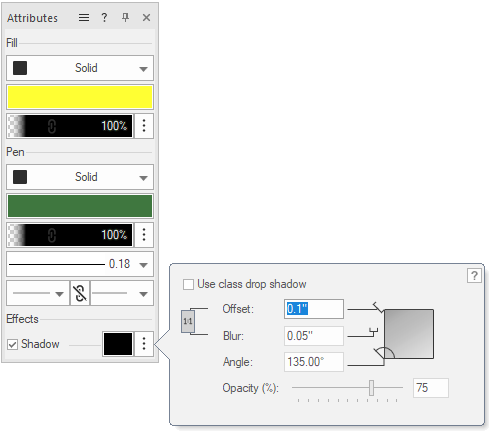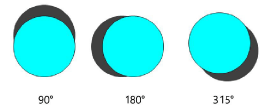Drop shadow attributes
Drop shadows can be applied to any graphical object in Top/Plan view, including symbols, walls, text, plug-in objects, and sheet layer viewports. The way shadows are cast varies depending on the type of object.
|
Object |
Shadow behavior |
|
Sheet layer viewport with no fill |
All objects floating on the background cast shadows, including viewport annotations. If you want drop shadows on annotations, but you do not want to apply drop shadows to the entire viewport, edit the viewport and apply drop shadows to annotations directly. |
|
Sheet layer viewport with fill |
The edge of the viewport casts a shadow, as do any annotations that fall beyond the edge |
|
Grouped objects |
Each object in the group casts a shadow |
|
Symbol |
2D objects in the symbol cast a single shadow; to create more shadows, edit the 2D component of the symbol, and apply drop shadows to the individual components |
|
Plants and massing models |
Plants and massing models have built-in shadow features; if Display Shadow is enabled in the Object Info palette for these objects, an applied drop shadow produces two shadows in plan view |
You can apply drop shadows to most objects from the Attributes palette. For styled walls, slabs, roofs, and roof faces, enable drop shadows in the attribute settings for the style that is applied to the object.
To apply a drop shadow to an object:
Select the object and select Shadow on the Attributes palette.
To change the drop shadow's color, click in the Drop Shadow Color area and select the desired color; see Applying colors.
Click the Drop Shadow Settings button to open the popover and define the desired settings.

Click to show/hide the parameters.Click to show/hide the parameters.
|
Parameter |
Description |
|
Use class drop shadow |
Uses the drop shadow values set by the class of the currently selected object; see Setting class attributes |
|
[page units]
|
Select to set the Offset and Blur to use page units; deselect to use world units |
|
Offset |
Enter the distance to offset the shadow from the object |
|
Blur |
Enter the extent of the blur applied to the shadow; a zero blur is a “hard” shadow, while a higher number makes the edge more blurred |
|
Angle |
Enter the angle of the shadow, measuring the degrees counter-clockwise from the right edge of an object
|
|
Opacity (%) |
Set the opacity of the shadow; drag the slider to the left to decrease the opacity, or enter an opacity percentage (0–100) to the right of the slider |



